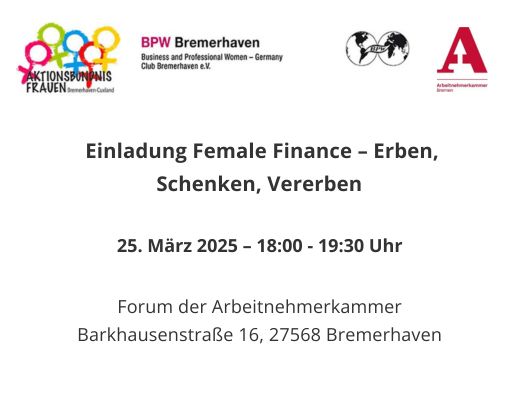Veranstaltungen

- Diese Veranstaltung hat bereits stattgefunden.
Female Finance – Erben, Schenken, Vererben
27. März um 18:00 bis 19:30

Sie glauben, bei Ihnen gäbe es nichts zu erben, zu vererben, zu schenken oder geschenkt zu bekommen? Und falls doch, dann jedenfalls in ferner Zukunft?
Tatsächlich sterben jedes Jahr in Deutschland rund 1 Million Menschen. Auch wenn es oft sicher nicht um große Vermögen geht, wird in der Regel etwas vererbt oder es gibt Dinge zu regeln. Was ist beispielsweise mit Accounts in Social Media oder Verträgen bei Internetanbietern? Haben Sie Ihre Daten so aufgelistet, dass sich im Fall eines Falles jemand anderes darin zurechtfände? Wissen um die rechtlichen Rahmenbedingungen für Schenkungen, Erben und Vererben kann unliebsame Überraschungen vermeiden helfen.
Das Thema Finanzen wird gerade bei Frauen oft ein wenig vernachlässigt, und im Erbfall stellt sich dann heraus, dass gute Absichten, Formulierungen in Testamenten oder auch geplanten Regelungen für die Erbfolge gar nicht geltendem Recht entsprechen.
Die Vortragsveranstaltung zum Thema soll daher Frauen einen Überblick über Fallstricke im Schenkungs- und Erbrecht geben. Die Referentinnen, Dr. Katja Ketzler und Daniela Pekic, sind Fachfrauen und haben das Thema Female Finance bereits mehrfach in sehr unterschiedlichen Facetten beleuchtet.
Der Eintritt ist frei. Um Anmeldung wird gebeten unter: aktionsbuendnisfrauen@bpw-bremerhaven.de
Diese Veranstaltung findet in Kooperation mit der Arbeitnehmerkammer Bremen und der Bremische Zentralstelle für die Verwirklichung der Gleichberechtigung der Frau (ZGF) im Rahmen der Frauenwoche 2025 statt.
Aktionsbündnis Frauen Bremerhaven-Cuxland:
Ein Zusammenschluss aus Organisationen, die sich für die Gleichstellung von Frauen einsetzen.
Auf einen Blick:
Wann: 25. März 2025 von 18:00 – 19:30 Uhr
Wo: Forum der Arbeitnehmerkammer, Barkhausenstraße 16, 27568 Bremerhaven
Mehr Veranstaltungen im Rahmen des Internationalen Frauentag sind hier zu finden: Veranstaltungen – weltfrauentag-bremen.de


